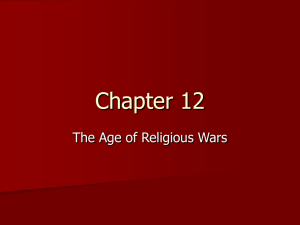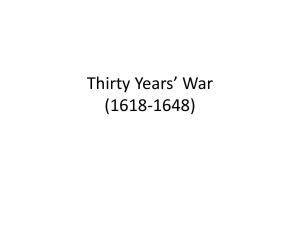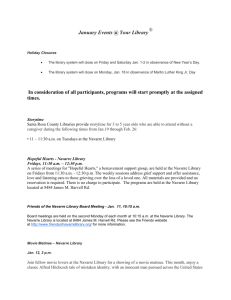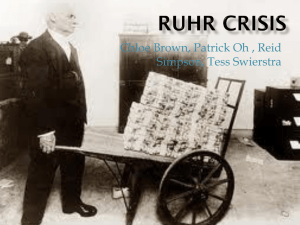Wars of Religion
advertisement
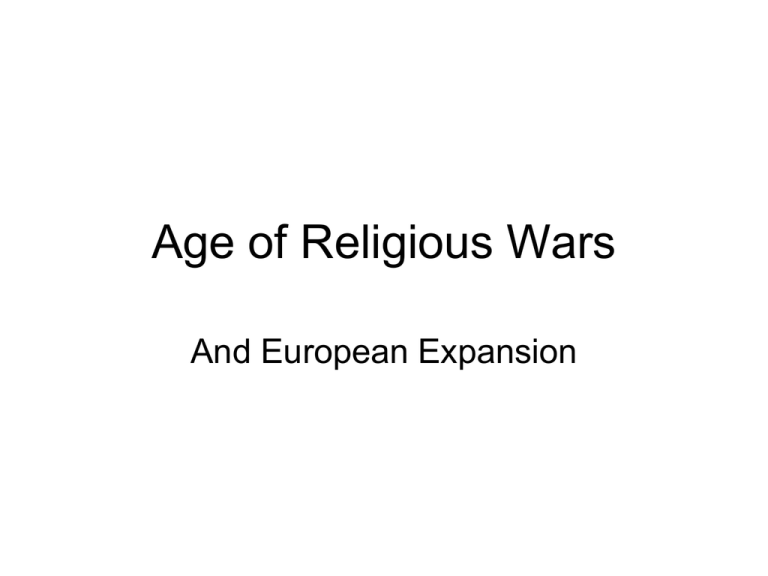
Age of Religious Wars And European Expansion • 1559—Treaty of CateauCambresis ended the Hapsburg-Valois Wars • Spain: gained control of Italy • Phillip II centers political activity on Spain • Two catholic powers: France and Spain shift from fighting each other to fighting PROTESTANTS Wars in 1500-1600s • Different than prior wars: • Armies bigger (up to 50,000) • Reorganized administration to finance armies • Use of gunpowder • Guns and cannons killed indiscriminately from a distance • Writers scorned gunpowder as coward’s weapon • Propaganda, pulpits, press Origins of problems in France • Francis I (1515-1547) • Henry II (1547-1559) • Small, efficient councils • Great nobles governed provinces • Paris: magistrates exercised fiscal/judicial responsibilities • 1539: ordinance passed that made all of France responsible to royal courts: French the language of those courts • Taille—supported both monarchy and army • Tax base too small for French spending • (arts and foreign policy) –Louvre, Dreux Castle –Tuileries –Il Rosso—Fontainebleau –Mona Lisa purchased –Leonardo hired • Habsburg-Valois Wars expensive: –Taxes increased –Heavy borrowing –Sale of public offices— new hereditary nobility •Nobility of the Robe –Treaty with papacy: Concordat of Bologna • Pope head of council • France could appoint all bishops and abbots • Monarchy had power over Church until 1789 • Established Catholicism as French state religion Results • French rulers no longer revolted against Rome • Disorder in French church • Church offices used as rewards • Intellectual/moral standards not elevated • Little attention to needs of laity • Protestant teaching spread • Luther’s ideas appeared in 1518 Calvin appears: 1536 • Wrote in French • Larger audience in France • Converts reformed-minded clergy • Middle class • Artisans • Paris, Lyons, Meaux, Grenolle • Many persecuted and burned, but 1/10 of French population became Calvinist Religious Riots and Civil War in France 1559-1598 • 1559: Power shift from France to Spain:Henry II dies at marriage tournament • Daughter Elizabeth of Valois married Phillip II of Spain • Connects two Catholic powers • Because of monarchial weakness, 2/5-1/2 French nobles become Calvinist • Three families dominate Political scene: • Bourbon--Huguenots • Montmorency-Chatillons-Huguenots • Guise--Catholic French Civil War • Two Sides: • Guise family led Catholics in north • Bourbons led Huguenots in south • Fighting for royal inheritance Art and architecture: Catholic: Baroque Protestants plain and simple • Catholic: Baroque • Presented life in a grandiose three dimensional display of raw energy • Ornamentation, marble sculptures, columns, paintings • Protestants: plain and simple • Keep worshippers focused on sermon • 1560: conspiracy of Amboise: –Condemned by Calvin— Tactics are a disgrace to the reformation –Francis II dies in 1560 dies of ear infection –Charles IX (under the regency of Catherine de Medici) –January Edict 1562—Issued –Granted Protestants freedom to worship outside of towns, privately within • End of religious toleration in France • Sparks the beginning of the French Wars of Religion • Conde and Huguenot armies did not support Catherine de Medici First War of Religion 1562-1563 • Begun by Massacre at Vassy in 1562 • Duke of Guise stopped in Vassy • Servants argued with Huguenots • Guise factions fired on unarmed Huguenots –Burned the church –Killed much of the congregation –Series of small battles/sieges follow –Duke of Guise assassinated Second War 1567-1568 • Population of Huguenots increased in South • Catherine began two-year tour of the provinces w/Charles IX • Part of an effort to establish sense of unity w/nobility • Rumor that Catherine was planning w/Spain to exterminate the Huguenots caused them to attempt a coup • Another series of small battles/sieges • Result: more debt for crown/little changed Third War (1568-1570) • Cardinal of Lorraine hatched a plot to overturn the peace and capture Conde and Coligny (protestant leaders) • Conde was killed • Coligny assumed leadership • Coligny met the Catholics at Moncoutour and was defeated • Regrouped his forces and defeated the royal army— deprived the crown of their chance to break the Protestant hold on the South • Crown racked up debt by keeping the army in the field and negotiated peace • 3rd war ended by Peace of Saint-Germain –Protestants could fortify cities –Granted religious freedom within territories –Returned confiscated properties –Results of Third War –Raised tensions between protestants and Catholics –Brought war, suffering to rural areas in South of France St. Bartholomew’s Day Massacre St. Bartholomew’s Day Massacre 1572 • Aug 17, 1572: Henri de Navarre married Margot de Valois • Festivities last until Aug. 23 • Aug 22: Admiral de Coligny shot by assassin • Suffers broken arm, severely wounded • Suspected the Guises • Huguenots wanted justice from King; and they wanted Coligny to flee At the Louvre • Charles IX, Catherine de Medici, Henri d’Anjou decide to kill Coligny and Huguenots • Charles IX: “Well kill them all that no man be left to reproach me.” • Charles’ soldiers go to Coligny’s door; shot guard; ran through the house; dragged Coligny from bed—stabbed him thru/ threw body from window • Duc de Guise mocked the body/kicked in face/said it was King’s will • Militia/general population went on rampage, sanctioned by church and king: • Wore white crosses on hats • Butchered their neighbors • Killing lasted 3 days Henri de Navarre • Slept in bridal suite in Louvre • His entourage of 40 Huguenots killed • Henri de Navarre/Henri de Conde dragged before King Charles IX and threatened w/death unless they converted to Catholicism • Both converted; Navarre became prisoner of court for 4 years • In Provinces: massacres lasted for months Massacre Results • Generation of Huguenot leaders destroyed • Henri de Navarre prisoner • Conde eventually escapes to Germany • Andelot, Coligny’s brother, became exile in Switzerland • Protestant Church in France begins its decline • Protestants: abjured faith or became radicals –Profound distrust of king; unwillingness to disarm; upsurge in political rhetoric of resistance 4th War (1572-1573) • La Rochelle: de facto capital of Protestants: refused to pay taxes to king b/c of massacre; refused to admit royal governor; • King Charles IX declared war in November • Army besieged La Rochelle in February • King’s army led by Henri d’Anjou and Henri de Navarre (as hostage) • La Rochelle: port city; easily resupplied by sea; nearly impregnable harbor; not easily reduced. • Result: High casualties on both sides • Royal treasury strained • Siege called off in May • Catherine de Medici had plans for Henry de Anjou: to ascend Polish throne • Treaty of La Rochelle: ends war; not advantageous to protestants. 5th War (1576) • 1574--Charles IX died “sweating blood and tormented w/guilt for Massacre” • Henri d’Anjou, King of Poland, abdicates Polish throne and returns to France to claim French Throne as Henri III Henri’s problems: • Conde raised troops, money, support from German princes • Feb 1576: Navarre escapes court to his own territory and raised and army. • Henri III’s brother, Duc d’Alencon, began anti-royalist campaign that portrayed himself as an alternate king: more fair and tax-cutting • They formed a strong alliance: Catherine de Medici could not counter it—20,000 troops invade France under Jan Casimir • Casimir’s troops met up w/additional armies and Catherine forced to negotiate. • Edict of Beaulieu (Peace of Monsieur) signed in May –Great settlements for leaders –Navarre made governor of Guyenne –Conde—governor of Picardy –Alencon—Duc d’Anjou and given many titles –Jan Casimir—crown paid for his mercenaries –Henry III angry; Parlament of Paris did not register the settlement; some towns ceded to Protestants did not let them in 6th War (1577) • 1576: Spring convocation of Estates General held few Protestant delegates • Advocated 1 religion in France • Henri III wanted new taxes and revenues to finance the government • National debt was unbearable • 1st Attempt at formation of a Catholic League (to oppose Protestants if King would not) • Henri III makes himself head of the League • Royal force formed: Protestant towns along the Loire River were re-taken; Protestants remained strong in the South • Peace of Bergerac July 1577 –More restrictive on worship, but same as Edict of Beaulieu –Disallowed any leagues and associations (fear of Catholic Right) 7th War (1580) • Lover’s war—very brief • Navarre seized city of Cahors: maneuvering between Navarre and crown • Queen Margot also involved • Treaty of Nerac and Peace of Felix signed • Navarre consolidated his control in the SW • Duc d’Anjou tried to gain favor in Netherlands; died in 1584; • New crisis: only heir to throne: Navarre War of the 3 Henries (1584-1589) • Crown was Catholic • Role of “Most Christian King” • Fundamental ideals for France • Pope Sixtus V immediately excommunicated Navarre and his cousin (Henri de Conde) • Both were heretics • Unfit for crown • Some Catholics resented papal interference; others wanted to seize crown • Duc de Guise: found pedigree tracing back to Charlemagne • In Guise tradition, named himself defender of Catholic Church • Henri III begs Henri de Navarre to convert to make the throne legitimate • Navarre not ready: needed current base of support • Duc de Guise revived Catholic League –To prevent a heretic from coming to the throne Dec 1584: Treaty of Joinville • Signed between Guises, Catholic League, and Philip II of Spain • Spain gives enormous sum to Catholic League and Guise pockets for 10 years. • Catholic League: strong noble base, much territory and middle class urban following • Henri III tries to overpower Catholic League again: makes himself head Treaty of Nemours 1585 • Revoked all previous edicts –Reformed religion banned –No Protestants in Royal offices –Evacuation of all garrisoned towns –All protestants abjure faith in 6 months or be exiled • Catholic League (Guises) hold N/E • Navarre & Conde hold S/W—they look for aid from Germans and Queen Elizabeth I • 1587—Jan Casimir leads German mercenaries to France—defeated by Guises • Navarre defeats Henri III’s army at Coutras • In Paris: growing dissatisfaction w/Henri III failure to suppress Protestants • 1588: Paris uprising: Barricades in streets • Henri III leaves Paris Estates General 1588 • Catholic League pressed for meeting • Want to crown Cardinal de Bourbon (Navarre’s uncle)— he was old/could be Guise puppet • Widespread fear of Henri’s abdication of Guise King • Dec. 24, 1588: Guise invited to visit Henri III in his quarters: archers lined stairs; 40 men in waiting room—Guise entered and doors bolted; Guise cut to pieces; body burnt; bones dissolved; ashes scattered; Cardinal de Guise suffered same fate Result of Guise murders • Duc de Mayenne (Guise)— Catholic League leader • Prints revolutionary tracts • Sorbonne—taught it was just and right to depose Henri III • Encouraged private citizens to commit regicide • League sent army against Henri III • Henri III turns to Henri de Navarre and they reclaim Paris July 1589 • Jacques Clement, monk, begs audience w/King Henri III • Puts long knife into his spleen: wound festered • On his deathbed, he calls for Navarre and named him as heir Wars of the League 1589-1598 • Henri IV (Navarre) delicate position • Some of Henri III’s followers support him, others do not • Catholic League staged coups in principle cities • Reign of terror: political correctness of citizens: moderate Catholics, Protestants, suspicious people hung • Duc de Mayenne: w/support of Spanish $ took army to field • Henri IV takes war out of south to north (necessary to get full support and become King of France) • 9/1589: Armies meet; Mayenne defeated at Arqeues; Throughout winter, Henri IV takes town after town • 3/1590 League suffered crushing defeat at Ivry; Cardinal de Bourbon died • Spring/Summer 1590—Henri IV reduces Paris to severe hunger; Allows women and children to leave • Philip II of Spain alarmed –Sent Duke of Parma to relieve the siege of Paris –Parma re-supplied the City –Henri IV forced to withdraw. 1593 Estates General • Catholic League called meeting • Need (Catholic) candidate for throne of France • Spanish proposed Infanta (Philip II’s infant daughter by Elizabeth de Valois, Henri III’s • sister) She would in the future marry a noble like the Duc de Guise • Departure from Salic Law • Parliament passed decree: no foreigners would get crown Startling turn of Events • Henry IV abjured his faith in July, 1593— “Paris is worth a mass.” • Coronated in Chartres, not Reims, b/c it was still in the hands of the Catholic League • Result: • Blow to the League • Many did not trust the conversion, esp. Protestants: hoped it was a ploy • Some Protestants withdrew support Triumphal Entry of Henry IV Into Paris – Peter Paul Reubens • Spring, 1594: Henri IV enters Paris: No war; Spanish leave • Henri IV begins program to win people over: charm, force, money, promises • Spanish tried to take territory until financial problems & Henri’s victories force them to sign the Treaty of Vervins, and they withdraw. • 1598: Edict of Nantes: granted Huguenots liberty of conscience and public worship in 150 fortified towns; paved way for absolutism by restoring internal peace in France
